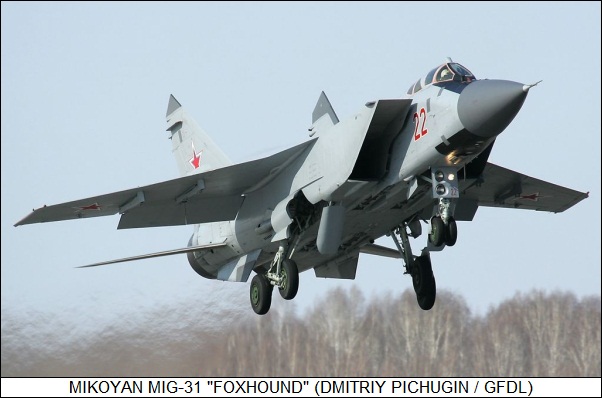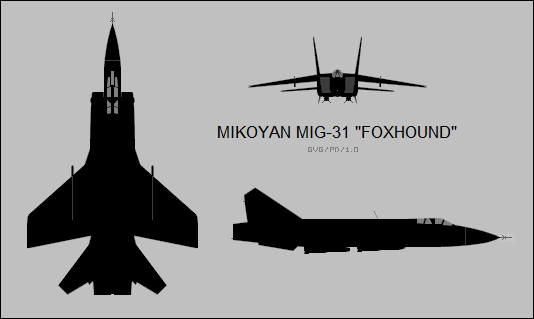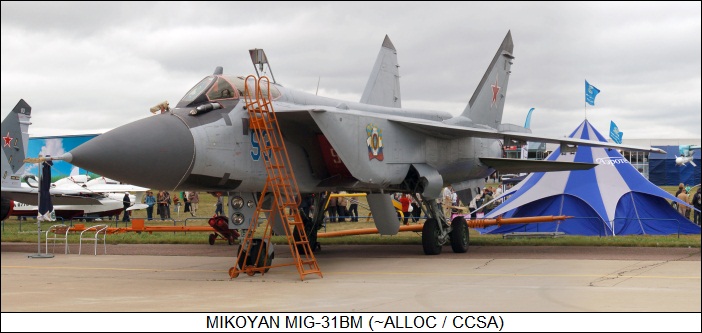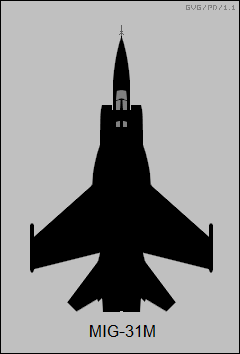
* Although the MiG-25 had been a considerable advance in combat aircraft design, it still left something to be desired, and advanced American aircraft were introduced in the 1970s that eroded its edge. As a result, the Soviets developed a substantially improved and more sophisticated derivative of the MiG-25, the "MiG-31", and fielded it in substantial numbers.

* During the 1960s, the West increasingly focused on low-level strike tactics that promised to be highly effective in penetrating Soviet air defenses. In response, the Soviets invested a great deal of effort in building up those defenses. After considering a number of different options, in 1968 work was authorized on a follow-on to the MiG-25 interceptor series.
The improved machine was to provide a general increase in capability and effectiveness over the Foxbat. The Mikoyan OKB considered more radical designs to meet the requirement early on, including swing wing and delta wing configurations, but decided that it would be more effective to retain the basic arrangement of the MiG-25, and give it a thorough workover.
The OKB's investigation led to an order for full development and two prototypes, with the design effort conducted by a team under the Mikoyan OKB's Gleb Lozino-Lozinsky, and the prototypes built in the OKB workshops. The first "Ye-155MP" prototype performed its initial flight on 16 September 1975, with Fedotov at the controls, and the second followed in May 1976.
Viktor Belenko mentioned the new machine during his debriefing by Western intelligence, describing a "Super Foxbat", with two seats, a strengthened fuselage for low-altitude flight, and a powerful look-down / shoot-down radar. Exaggerated details leaked in the Western press led to a best-selling technothriller novel, Craig Thomas's FIREFOX, involving a Soviet super-fighter with Mach 3 performance, vertical take-off capability, and direct mind control over aircraft systems; the novel led in turn to one of the worst movies Clint Eastwood ever made -- but that's another story.
Work on what would become a total of eight preproduction machines began at the factory in Gorky in 1977. In 1978, a US spy satellite observed one of the evaluation machines, flying at 6,000 meters (20,000 feet), intercepting a target drone emulating a cruise missile flying at 60 meters (200 feet) and 20 kilometers (12.5 miles) away. That was impressive, though since the Soviets were perfectly aware of the orbital schedules of American spy satellites, it suggests the whole thing was a staged "photo-opportunity".
Trials continued into 1980, leading to a formal authorization in 1981 of full production of what was originally to be designated the "MiG-25MP" but emerged as the "MiG-31". The type entered front-line PVO service in 1982, replacing the Tu-128 Fiddler. Aircrew were impressed by the MiG-31's sophistication, range, speed, and said it could climb "like a rocket". Like the MiG-25 before it, the MiG-31 was not very maneuverable, but there was really no need for it to be.
NATO assigned the MiG-31 the reporting name of "Foxhound". The West finally got good pictures of the MiG-31 in 1985, when a Norwegian pilot intercepted one over the Barents Sea and took some shots of it. That was almost certainly a photo-opportunity, the Soviets having long used such intercepts as a means of unveiling new aircraft to the West, with the aircraft turning back for home the moment the photo session was over.
BACK_TO_TOP* As introduced, the MiG-31 was clearly a derivative of the MiG-25; they were similar enough for the two to be confused at a casual glance. They were both slab-sided aircraft with twin engines featuring ramp inlets, a high-mounted swept wing, twin tailfins, and ventral fins. However, any more than a casual glance showed the MiG-31 to be clearly different from the MiG-25.
The first visible difference was that the MiG-31 was built from the start as a two-seat aircraft. The Soviets had finally decided that a completely ground-controlled approach to air defense was too inflexible, and so the MiG-31 was designed to be able to hunt and fight more or less independently, with a back-seater directing the pilot to targets using a much improved sensor suite, and controlling the weapons systems. The USSR did not have a continuous ground-based air-defense barrier such as the US-Canadian DEW line; the MiG-31 could be used to plug the gaps.
The two crew were placed in tandem under individual rear-hinged clamshell canopies, though the design team did consider a side-by-side arrangement as well. The crew sat on Zvezda K-36DM "zero-zero" (zero speed, zero altitude) ejection seats, which had built-in massage pads to keep the crew more comfortable on long patrol missions. The cockpits were painted using a dark turquoise color scheme, often used on Soviet-Russian aircraft, having been judged by Soviet ergonomics experts as relaxing for aircrew. The rear cockpit featured a simple set of flight controls and a retractable periscope, to allow the back-seater to get the aircraft home in an emergency, as well as to provide flight training without a specialized trainer variant.

The MiG-31's wing was also noticeably different from the MiG-25's, with leading-edge root extensions with a sweep of 70 degrees and a thinner cross-section. Each wing featured four-section leading-edge slats; two-section trailing-edge flaps; and outboard flaperons. The leading-edge flaps deployed automatically at low speeds, and were also used for combat maneuvering. The fuselage and engine inlets were designed to contribute to lift. The redesigned fuselage also featured increased fuel capacity. Airbrakes were fitted under the engine inlets and forward of the main gear doors.
The landing gear was new and distinctive as well. The two-wheel nosegear was moved forward relative to the MiG-25, retracting backward instead of forward as on the MiG-25, and the main gear featured two wheels, arranged in tandem but offset. That prevented the rear wheel from following in the rut created by the front wheel as it rolled over snow or mud. The MiG-31 used twin cruciform brake parachutes, stowed in a fairing between and above the engine exhausts.
The Foxhound's primary weapon was the big "R-33" (NATO "AA-9 Amos") SARH AAM, roughly in the same class and strongly resembling the US Hughes AIM-54 Phoenix long-range AAM used on the Grumman F-14 Tomcat. Some sources have suggested that the R-33 is actually, to some lesser or greater degree, a copy of the Phoenix, with the design details obtained from samples of the Phoenix obtained from Iran after the Islamic Revolution in that country. The MiG-31 could carry four R-33s in recesses under the fuselage, in an arrangement along the lines of that used by the Tomcat to carry its Phoenix AAMs. An R-33 swung down on a hydraulically actuated trapeze for launch. All four missiles could be launched in salvo, with each seeking out a different target in parallel.
The Foxhound had four underwing pylons, though apparently early machines only had two, which could be used to carry the R-40TM / AA-6 Acrid, R-60M / AA-8 Aphid, or newer "R-77" ("AMRAAMski / NATO AA-12 Adder") missiles. Typical warload was four R-33s under the fuselage and two or four R-60s on the underwing pylons, or three R-33s under the fuselage, the fourth position being taken up by a controller pod for two underwing R-40s.
A 2,500-liter (660 US gallon) external tank could be carried by each outboard pylon. The MiG-31 actually had gun armament, consisting of a GSh-6-23 six-barreled 23-millimeter Gatling cannon mounted in a fairing set well back on the belly of the aircraft, just behind the right main landing gear door. The cannon had a rate of fire from 6,000 to 8,000 rounds per minute, and the MiG-31 carried an ammunition store of 260 rounds.
The airframe featured more titanium and aluminum alloy than the MiG-25. The MiG-31 was powered by two Aviadvigatel D-30-F6 bypass jet engines, with an impressive afterburning thrust of 152 kN (15,500 kgp / 34,175 lbf) each, as well as fuel economy unimaginable with the old RB-15 engines. The engine intakes, which were the focus of considerable design effort to ensure better efficiency, featured an upper moving inlet ramp and a lower moving inlet lip. There are auxiliary inlet doors on top of the intakes.
* Avionics were significantly improved. The main sensor was the SBI-16 (S-800) "Zaslon" ("Shield" / NATO "Flash Dance") phased-array / electronically steered radar, the first such type of system to reach first-line service in a Soviet fighter, with 120 degrees coverage; excellent look-down / shoot-down capabilities; maximum detection range of 200 kilometers (125 miles); and maximum tracking range of 120 kilometers (75 miles). The radar could track ten targets and engage four of them at one time, with the targets prioritized by the interceptor's mission computer. A semi-retractable TP-8 IRST was also fitted as a passive sensor. Both were linked into an Argon-15 digital fire-control computer.
Although the MiG-31 was capable of autonomous operation, the Soviets did not abandon their ground-control network by any means, and the Foxhound could be directed semi-automatically by the AK-RLDN ground-based automatic guidance network, using the aircraft's APD-518 digital datalink and BAN-75 command link. The datalink could also be used to hook up the fighter to an Ilyushin A-50 "Mainstay" airborne warning and control system (AWACS) aircraft, as well as allow "wolfpacks" of four MiG-31s to cooperate under the control of a flight leader, covering a swath of airspace 900 kilometers (560 kilometers) wide. The flight leader could direct his three wingmates to specific targets.
The MiG-31 featured other improved avionics, including updated radios; IFF; RWR; and particularly an NK-25 navigation system, featuring receivers for the Tropik medium-range radio navigation system, similar to the US LORAN, and the Marshrut long-range radio navigation system, similar to the US Omega. One of the motivations for such extensive navigation gear was to allow the Foxhound to patrol deep into Arctic airspace in search of Western cruise-missile carrier aircraft. Trial flights included such deep-Arctic sorties, including one that overflew the North Pole.
________________________________________________________________________
MIKOYAN MIG-31 INTERCEPTOR ("FOXHOUND"):
________________________________________________________________________
wingspan:
13.46 meters (44 feet 4 inches)
wing area:
61.6 sq_meters (663 sq_feet)
length:
22.69 meters (74 feet 6 inches)
height:
6.2 meters (20 feet 4 inches)
empty weight:
21,825 kilograms (48,115 pounds)
normal weight:
41,000 kilograms (90,388 pounds)
MTO weight:
46,200 kilograms (101,851 pounds)
max speed at altitude:
3,000 KPH (1,865 MPH / 1,620 KT)
service ceiling:
20,600 meters (67,585 feet)
take-off run:
1,200 meters (3,940 feet)
ferry range:
3,300 kilometers (2,050 MI / 1,780 NMI)
operational radius:
1,200 kilometers (745 MI / 648 NMI)
________________________________________________________________________
The MiG-31 proved to be highly satisfactory in operational service; field commanders began to consider it for other missions, such as escort of long-range maritime patrol aircraft. That strained the range of the Foxhound, and so the MiG OKB designed a semi-retractable flight refueling probe that was fitted to the left side of the nose. The probe was introduced into standard production.
* In 1985, Soviet security arrested Adolf Tolkachev, head of the Phazotron radar design bureau, for selling secrets to the West. Tolkachev had compromised the radar systems of most of the USSR's first-line combat aircraft. The Soviets took a very dim view of traitors and Tolkachev was executed, but the damage had been done: the MiG-31's radar had been compromised, allowing it to be neutralized through countermeasures. The MiG OKB had already been working on improvements to the Foxhound, and came up with a new Foxhound variant, the "MiG-31B", which featured a new Zaslon radar with improved range and counter-countermeasures; as well as other updated avionics, including modernized digital processors; plus support for the improved R-33S AAM and fit of the inflight refueling probe as standard.
The MiG-31B entered production in 1990. The Gorkiy factory updated many early-production MiG-31s to the same standard, with these machines receiving the designation "MiG-31BS".
BACK_TO_TOP* A total of about 500 MiG-31s was built by the factory at Gorkiy up to the fall of the USSR. There were several minor and proposed Foxhound modifications and variants.
One early MiG-31 was used for test duties at the Zhukovsky flight center, and given the designation of "MiG-31LL", the "LL" standing for "letuchaya laboritoriya (flying laboratory)" -- a common suffix for Soviet trials aircraft.
Under the "Kontakt" program, two specialized MiG-31s were built in 1987 as carriers for an antisatellite (ASAT) missile, in imitation of a contemporary US ASAT program that used a McDonnell Douglas F-15. These two Foxhounds featured triangular "webbed feet" wing endplate fins, like those fitted to some MiG-25 prototypes, in this case intended to provide improved flight stability at high altitudes for missile launches. A single large missile was to be carried under the fuselage, and a special upward-looking radar and associated intercept fire-control system was to be fitted to production machines. The cannon was deleted.
The effort was suspended in the early 1990s -- one reason, aside from the social chaos in Russia at the time, likely being the fact that attempts to build ASAT weapons have traditionally bogged down once the realization sinks in that shooting down the other side's satellites simply invites retaliation in kind, leaving all worse off. These aircraft were given the designation of "MiG-31D", which is also confusingly sometimes applied to initial production MiG-31s with refueling probes, as well as to a bewildering range of other Foxhound variants, both real and imaginary. For simplicity, this ASAT launcher is the only Foxhound variant referred to as the MiG-31D in this document.
The MiG-31D was resurrected in the late 1990s as the "MiG-31A" proposal, with the aircraft being used to launch a small satellite ("smallsat") payload of up to 100 kilograms (220 pounds) into orbit, instead of an ASAT interceptor. This program didn't go anywhere either, but in 2005 a collaboration of Russian and Kazakh organizations announced that a program to perform space launches with the MiG-31 had been initiated with backing from the governments of both countries. A solid-fuel booster named the "Ishim", after a river that runs through both Russia and Kazakhstan, was to be designed and built as part of the program, with the Ishim capable of placing a 160-kilogram (350-pound) satellite into low Earth orbit.
The idea was interesting, but it then disappeared -- but in 2017, the ASAT concept resurfaced, with the MiG-31BM to be the launch platform. There has been further talk of using the MiG-31 as an ASAT or smallsat launcher, but it hasn't gone beyond talk.
The MiG OKB showed off a multi-role fighter variant of the MiG-31B at the Paris Air Show in 1995. This machine was designated the "MiG-31F", with "F" standing for "frontovy / front AKA tactical", and was fitted with air-to-surface weapons for the strike or particularly the SEAD role. It is unclear if this particular aircraft had avionics systems to support such weapons; it may have been a more or less conventional MiG-31B that had been "jazzed up" with them for show purposes to run the idea up a flagpole and see if anyone saluted. Nobody did.
The MiG OKB proposed a "MiG-31E" interceptor for the export market, which was essentially a MiG-31B with downgraded avionics. One or two prototypes were built. The MiG organization came up with improved proposals for export machines, but there have been no export sales of the Foxhound.
* In the mid-1980s, the MiG OKB began work on an improved interceptor variant, the "MiG-31M", which was primarily designed as a carrier for the R-37 AAM, an improved follow-on to the R-33 with an astounding range of 300 kilometers (186 miles). Seven MiG-31M prototypes were built, with the first flying in late 1985.
An improved Zaslon-M radar was fitted, along with a new IRST featuring a laser rangefinder. A new "fat" spine was fitted to the aircraft to accommodate improved avionics and increase fuel storage. At least one prototype featured wingtip pods with vertical fins for electronic systems. Large LERXes were fitted to improve high angle of attack handling; the tailfins and ventral fins were reconfigured to a degree; and an improved inflight refueling probe was designed, to be fitted to the right side of the nose of the aircraft.
Six R-39s could be carried under the fuselage in recesses, arranged as three rows of two missiles. All six could be launched in salvo and seek different targets. Four R-77 AAMs could also be carried on underwing pylons. The cannon was deleted. The cockpit was redesigned, with the front seater getting a new single-piece windscreen, and the windows for the back-seater reduced to a small panel on either side to allow him to focus his attention on his displays. Back-seat flight controls were deleted.
* The MiG-31M did not enter production since the Russian state lacked the money to buy many new aircraft, and so in 1997 the MiG organization began work on a multi-role upgrade to existing MiG-31s, designated "MiG-31BM".

A MiG-31BM prototype was demonstrated publicly in 1999. It featured an updated Zaslon radar close to Zaslon-M standards; a satellite navigation receiver; and significantly upgraded cockpit arrangements, with the back-seater provided with three large flat-panel displays. It is unclear if the cockpit arrangements were inherited from the MiG-31M or, as would seem likely given technological advances since the 1980s, used more advanced systems. The MiG-31BM could carry six R-33S or R-37 AAMs, as well as underwing stores such as smaller AAMs, ARMs, or iron bombs.
The program moved along slowly, but by late 2006 the Russian Air Force (which absorbed the disbanded PVO after the fall of the USSR) was performing flight trials on two MiG-31BMs. In 2011, the service committed to upgrading 60 machines by 2020; the fleet has now been fully upgraded for service with the "Russian Aerospace Forces (VKS)", as the organization is now known.
A new version of the MiG-31, the "MiG-31K", was publicly unveiled in 2018; it was just a minor modification of stock MiG-31s to carry the "Kinzhal (Dagger)" solid-fuel air-to-surface missile, itself a modification of the "Iskander" tactical ballistic missile. The MiG-31K saw considerable action following the Russian invasion of Ukraine in early 2022, launching Kinzhal missiles against Kyiv and other targets in Ukraine.
There has also been work on a MiG-31 ASAT / smallsat launcher, in the footsteps of the Kinzhal carrier. In addition, the MiG organization has worked on a replacement for the MiG-31, the "MiG-41", AKA "Prospective Air Complex For Long-Range Interception" or "PAK-DP" in its Russian acronym. However, the Ukraine War was a military, social, and economic disaster for Russia that is likely to derail long-range plans for some time to come.
BACK_TO_TOP* MiG-25 Foxbat interceptor and SEAD variants included:
MiG-25 reconnaissance variants included:
MiG-25 trainers and miscellaneous variants included:
* MiG-31 Foxhound variants included:
* I thought that writing up the MiG-25 and MiG-31 would be a straightforward exercise. I wasn't thinking. It turned out to be much more work than I expected: as with most Soviet-Russian aircraft, different sources on the MiG-25 tend to give frustratingly different stories, particularly in terms of variant descriptions and designations.

I remember from when I was a kid back in the 1960s how impressive the Foxbat seemed in the West. It is a bit surprising to look back from the 21st century and find that it has something of an outdated "boilerplate" appearance, and that the type has been, if not precisely forgotten, at least neglected. Information on it, particularly good information, tends to be hard to come by.
* Sources include:
* Revision history:
v1.0.0 / 01 nov 03 v1.0.1 / 01 sep 05 / Review & polish. v1.0.2 / 01 may 07 / Review & polish. v1.0.3 / 01 apr 09 / Review & polish. v1.0.4 / 01 mar 11 / Review & polish. v1.0.5 / 01 feb 13 / Review & polish. v1.0.6 / 01 jul 14 / Review & polish. v1.1.0 / 01 jun 16 / Moved comments on Belenko around. v1.1.1 / 01 may 18 / Review, update, & polish. v1.1.2 / 01 mar 20 / Review, update, & polish. v1.1.3 / 01 jan 22 / Review, update, & polish. v1.1.4 / 01 dec 23 / Review, update, & polish. (++)BACK_TO_TOP
